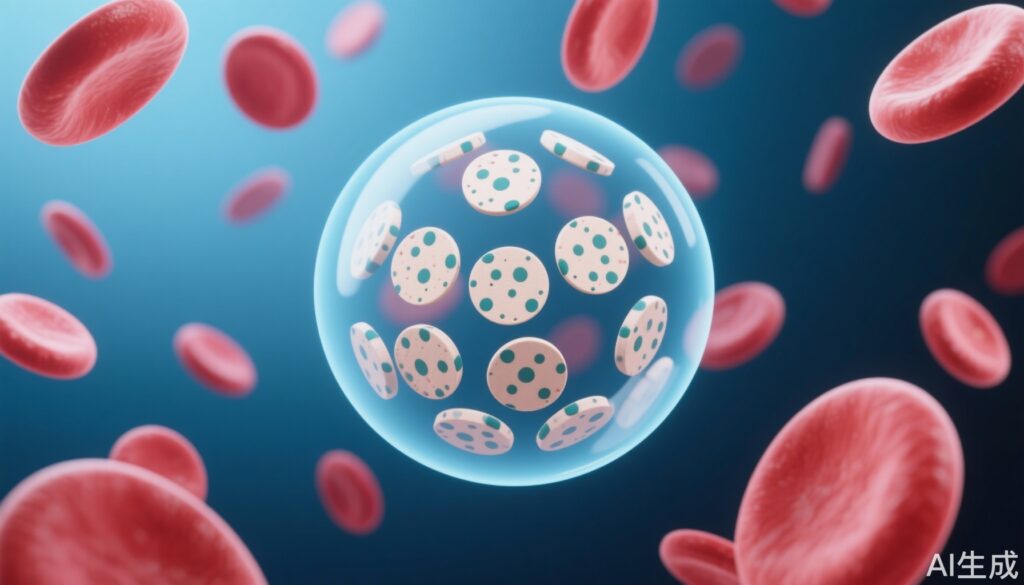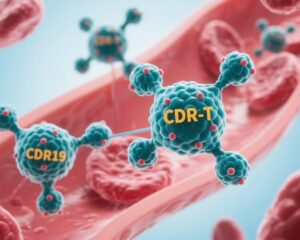Highlight
- T-ICAHT is a newly developed grading system assessing thrombocytopenia after CD19 CAR T-cell therapy, based on depth, duration, and timing.
- Early (days 0-30) and late (days 31-100) thrombocytopenia are frequent, with severe cases occurring in approximately one-fifth to one-eighth of patients.
- Higher T-ICAHT grades correlate with increased transfusion requirements, more bleeding events, and independently predict worse overall survival.
- The grading system’s prognostic validity is confirmed across multiple hematologic malignancies, supporting its integration into the ICAHT framework.
Study Background and Disease Burden
Chimeric antigen receptor (CAR) T-cell therapy represents a breakthrough immunotherapy for relapsed or refractory B-cell malignancies, particularly B-cell non-Hodgkin lymphoma (B-NHL). While highly effective, CAR T-cell treatments have distinct toxicities, including immune-related adverse events and hematologic toxicities. Immune effector cell-associated hematotoxicity (ICAHT) was recently established to categorize treatment-related cytopenias distinctly from cytokine release syndrome or neurotoxicity. Initially, ICAHT grading focused predominantly on neutropenia, termed N-ICAHT. However, thrombocytopenia—deficiency of platelets critical for hemostasis—remained less characterized despite its clinical relevance. Uncontrolled thrombocytopenia increases bleeding risk, transfusion dependency, and may impact survival. Given the expanding indications for CAR T-cell therapy, better understanding and standardized grading of thrombocytopenia are essential for patient monitoring, risk stratification, and therapeutic decision-making. This study addresses this critical gap by evaluating thrombocytopenia patterns following commercial CD19 CAR T-cell therapy in a large multicenter lymphoma cohort and proposing a comprehensive grading system, T-ICAHT.
Study Design
This observational multicenter study included 744 adult patients treated with commercial CD19 CAR T-cell products for B-cell non-Hodgkin lymphoma across multiple centers. The study analyzed platelet count trajectories during the first 100 days post-infusion to characterize early (day 0-30) and late (day 31-100) thrombocytopenia. A novel grading system termed T-ICAHT was developed, incorporating magnitude of platelet reduction, duration of thrombocytopenia, and timing relative to therapy. The T-ICAHT thresholds were aligned with the established neutrophil-based N-ICAHT grading criteria for consistency. Multivariate analyses identified clinical and treatment-related factors associated with severe thrombocytopenia (grade ≥3). The associations between T-ICAHT grades and clinical outcomes including transfusion burden, bleeding events, and overall survival (OS) were assessed using landmark and Cox regression models. External validation of the grading system’s prognostic utility was performed using three independent cohorts encompassing 599 additional patients treated for NHL, multiple myeloma, and B-cell acute lymphoblastic leukemia.
Key Findings
Incidence and Severity of Thrombocytopenia
In the core NHL cohort, early T-ICAHT (within 30 days) occurred in 43% of patients, with severe thrombocytopenia (grade ≥3) in 23%. Late thrombocytopenia (days 31-100) was similarly prevalent at 42%, with 13% severe cases. There was moderate correlation between T-ICAHT and N-ICAHT gradings, reflecting related but distinct cytopenia profiles, with notable discordances highlighting the need to assess platelet counts separately.
Risk Factors
Multivariate analysis identified bridging therapy before CAR T-cell infusion, poorer performance status (ECOG), and elevated HEMATOTOX scores (a composite biomarker predicting hematologic toxicity) as independent predictors of severe early thrombocytopenia. These factors may denote patients with vulnerable hematopoietic reserves or more aggressive disease biology.
Clinical Impact and Outcomes
Higher T-ICAHT grades were strongly associated with a higher need for platelet and red blood cell transfusions and more frequent clinically significant bleeding events. Importantly, thrombocytopenia severity correlated inversely with OS at 2 years: grade 0 had 67% survival, grade 1-2 had 48%, and grade ≥3 had 35%. Cox regression demonstrated T-ICAHT as an independent prognostic marker for OS, beyond known clinical factors.
Validation and Generalizability
The prognostic value and clinical applicability of T-ICAHT were prospectively validated in three external cohorts including pediatric and adult patients with NHL, multiple myeloma, and B-cell acute lymphoblastic leukemia treated with CAR T therapies. The consistency of findings across diverse hematologic malignancies underscores the generalizability of the grading system.
Expert Commentary
The development of T-ICAHT marks a significant advance in defining hematologic toxicity after CAR T-cell therapy. Prior focus on neutropenia underrepresented the clinical importance of thrombocytopenia, which increases patient morbidity through bleeding risk and transfusion dependence. This study’s large, multinational dataset and robust multivariate modeling enhance confidence in identified risk factors such as bridging therapy and HEMATOTOX scores, which may reflect a collective impact of disease burden and pre-treatment marrow impairment.
The observed discordance between thrombocytopenia and neutropenia grades suggests that integrated assessment of multiple cytopenias is required rather than relying on single-lineage metrics. The strong association of T-ICAHT grades with survival supports thrombocytopenia as a biomarker of treatment response or residual disease impact on hematopoiesis. However, causal mechanisms behind prolonged thrombocytopenia remain to be elucidated and may involve marrow toxicity, immune-mediated platelet destruction, or disease relapse.
While the grading system provides standardized criteria, clinical judgment remains essential in addressing individual patient bleeding risks and supportive care. Future guidelines integrating T-ICAHT with other ICAHT components and immune-related toxicities are warranted. Moreover, mechanistic studies and therapeutic interventions targeting thrombocytopenia could improve patient outcomes post-CAR T-cell therapy.
Conclusion
The study by Rejeski et al. introduces T-ICAHT, a novel and validated thrombocytopenia grading system that captures important hematologic toxicity after CAR T-cell therapy with clear prognostic implications. Given its predictive value for transfusion needs, bleeding, and overall survival across multiple hematologic malignancies, T-ICAHT should be incorporated into the broader ICAHT framework. Standardizing thrombocytopenia assessment post-CAR T provides clinicians with an essential tool for risk stratification, monitoring, and guiding supportive care. Continued research into the pathophysiology and management of thrombocytopenia will be critical for optimizing CAR T-cell therapy safety and efficacy.
References
1. Rejeski K, Sanz J, Fei T, et al. T-ICAHT: grading and prognostic impact of thrombocytopenia after CAR T-cell therapy. Blood. 2025;146(7):834-846. doi:10.1182/blood.2025028833.
2. Neelapu SS, Locke FL, Bartlett NL, et al. Axicabtagene Ciloleucel CAR T-Cell Therapy in Refractory Large B-Cell Lymphoma. N Engl J Med. 2017;377(26):2531-2544.
3. Galli E, Monti M, Cainelli E, et al. Hematologic toxicities after CAR-T therapy: a systematic review and meta-analysis. Blood Adv. 2021;5(6):1787-1797.
4. Hill JA, Li D, Hay KA, et al. Infectious complications of CD19-targeted chimeric antigen receptor–modified T-cell immunotherapy. Blood. 2018;131(1):121-130.
5. Fried S, Avigdor A, Bielorai B, et al. Early and late hematologic toxicity following CD19 CAR-T cells. Bone Marrow Transplant. 2019;54(10):1643-1650.


